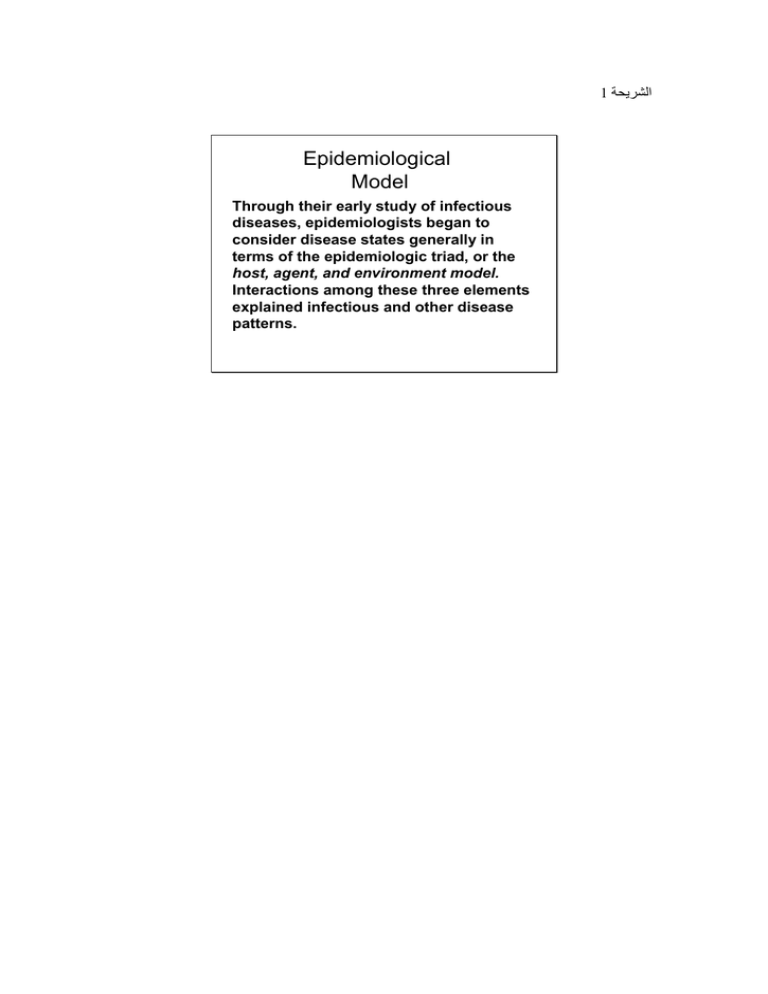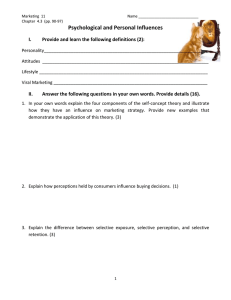Epidemiological Model ةحيرشلا 1
advertisement

1 الشريحة Epidemiological Model Through their early study of infectious diseases, epidemiologists began to consider disease states generally in terms of the epidemiologic triad, or the host, agent, and environment model. Interactions among these three elements explained infectious and other disease patterns. 2 الشريحة Host The host is a susceptible human or animal who harbors and nourishes a disease-causing agent. Many physical, psychological, and lifestyle factors influence the host’s susceptibility and response to an agent. Physical factors include age, sex, race, and genetic influences on the host’s vulnerability or resistance. Psychological factors, such as outlook and response to stress, can strongly influence host susceptibility. Lifestyle factors also play a major role. Diet, exercise, sleep patterns, and healthy or unhealthy habits all contribute to either increased or decreased vulnerability to the disease-causing agent. 3 الشريحة The concept of resistance is important for community health nursing practice. People sometimes have an ability to resist pathogens called inherent resistance. Typically, these people have inherited or acquired characteristics, such as the various factors mentioned earlier, that make them less vulnerable. For instance, people who maintain a healthful lifestyle may not contract influenza even if exposed to the flu virus. Resistance can be promoted through preventive interventions. 4 الشريحة Agent An agent is a factor that causes or contributes to a health problem or condition. Causative agents can be factors that are present (eg, bacteria that cause tuberculosis, rocks on a mountain road that contribute to an automobile crash) or factors that are lacking (eg, lack of iron in the body that causes anemia; lack of seat belt use that contributes to the extent of injury during an automobile crash). 5 الشريحة Agents vary considerably and include five types: biologic, chemical, nutrient, physical, and psychological. Biologic agents include bacteria, viruses, fungal, protozoa, worms, and insects. Some biologic agents are infectious, such as influenza virus or HIV. Chemical agents may be in the form of liquids, solids, gases, dusts, or fumes. Examples are poisonous sprays used on garden pests and industrial chemical wastes. 6 الشريحة The degree of toxicity of the chemical agent influences its impact on health. Nutrient agents include essential dietary components that can produce illness conditions if they are deficient or are taken in excess. For example, a deficiency of niacin can cause pellagra, and too much vitamin A can be toxic. Physical agents include anything mechanical (eg, automobile), material (rockslide), atmospheric (ultraviolet radiation), geologic (earthquake), or genetically transmitted that causes injury to humans. The shape, size, and force of physical agents influence the degree of harm to the host. Psychological agents are events that produce stress leading to health problems. 7 الشريحة Environment The environment refers to all the external factors surrounding the host that might influence vulnerability or resistance. The physical environment includes factors such as geography, climate, weather, safety of buildings, water and food supply, and presence of animals, plants, insects, and microorganisms that have the capacity to serve as reservoirs (storage sites for disease-causing agents) or vectors (carriers) for transmitting disease. 8 الشريحة The psychosocial environment refers to social, cultural, economic, and psychological influences and conditions that affect health, such as access to health care, cultural health practices, poverty, and work stressors, which can all contribute to disease or health. 9 الشريحة Host, agent, and environment interact to cause a disease or health condition. For example, the agent responsible for Lyme disease is the spirochete Borrelia burgdorferi; humans of all ages are susceptible hosts, along with dogs, cattle, and horses. Ticks that feed on wild rodents and deer transfer the spirochete to human hosts after feeding on them for several hours. Environmental factors, such as working or playing in tickinfested areas, influence host vulnerability. •





